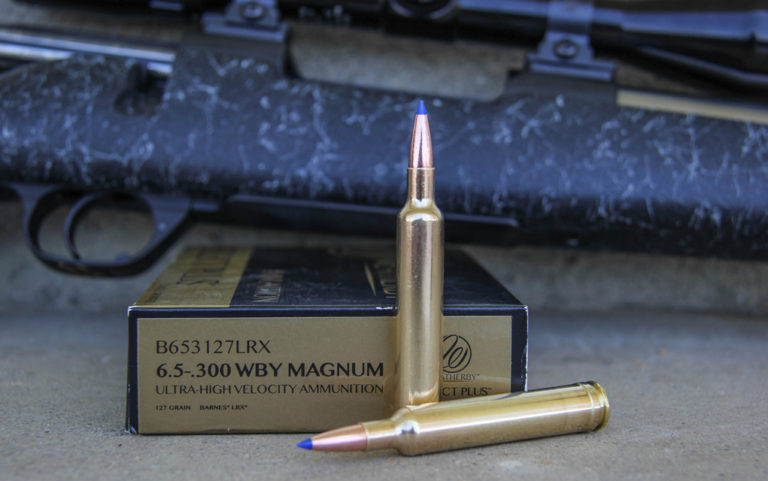
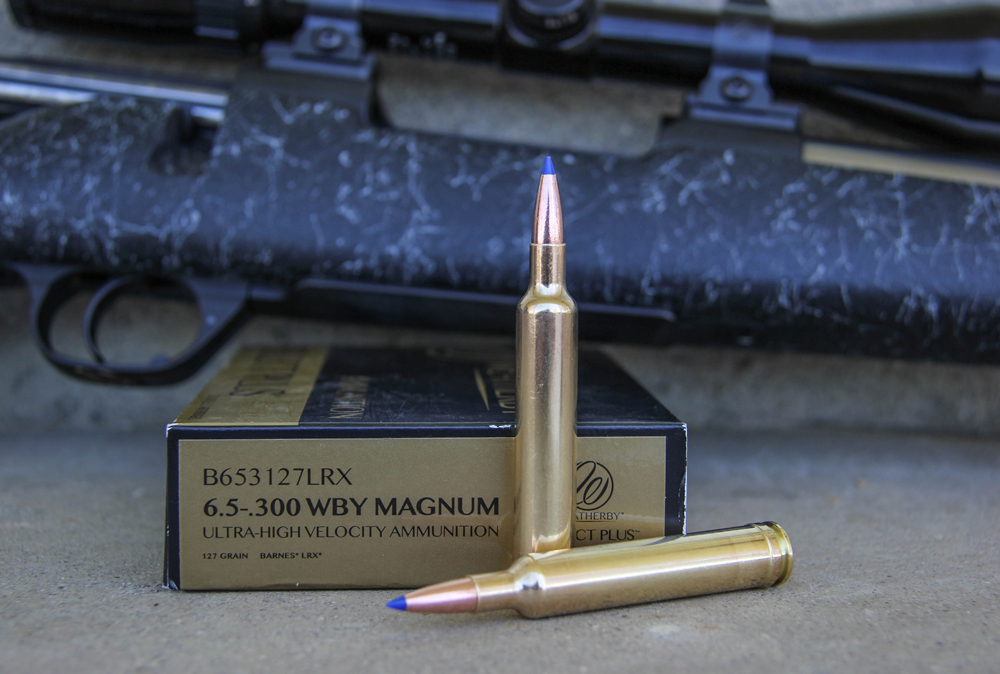 It’s been a while since Weatherby added a new cartridge to its stable, and its new thoroughbred, the 6.5-300 Weatherby Magnum, has horsepower to spare.
It’s been a while since Weatherby added a new cartridge to its stable, and its new thoroughbred, the 6.5-300 Weatherby Magnum, has horsepower to spare.
More than two decades ago, I sat down on a concrete bench at a rifle range in southern Ohio and touched off the very first centerfire round of my shooting career. That round was a .300 Weatherby Magnum; the rifle was a light sporter with a hard plastic butt plate that my grandfather owned. The memory of that first trigger break and the terrific roar and slap that followed will remain etched in my mind forever. As will the odd feeling of being snowed upon in July; the muzzle had been positioned just ahead of the foam gun case, and the blast sent the case’s foam innards high into the air. Very dramatic.
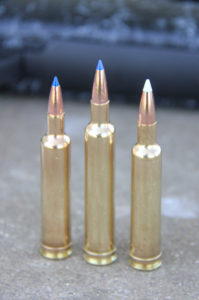
Fast-forward to the present day, and you’ll find me at that same range on that same bench. Things have changed a bit; time has taught me to handle recoil better, and the 70 pounds I’ve packed on since the early '90s have equipped me to deal with the punch of a powerful rifle. I’m shooting another Weatherby Magnum, this time through a Mark V rifle with a (thank goodness) soft recoil pad, and the cartridge itself is an offspring of the mighty .300 Weatherby that first ushered me into the world of centerfire shooting 20 years ago. This time the experience is far, far more enjoyable.
It had been 17 years since the team at Weatherby added a new magnum cartridge to their line, but that changed in 2015 with the announcement of the 6.5-300 Weatherby Magnum. The new round is based on the .300 Weatherby Magnum, which traces back to the .300 H&H Magnum. Roy Weatherby improved the H&H cartridge and gave his new .300 magnum the signature double-radius shoulder that became a trademark of the Weatherby brand. The 6.5-300 Weatherby Magnum, then, is simply a necked-down .300 Weatherby Magnum, and although wildcatters had played with the round for some time, it wasn’t officially part of the Weatherby lineup until last year.
Ten years ago it was proper to write that the 6.5 had never been a popular bullet choice for American hunters; the 6.5×55 Swede was popular in Europe, but it never became a standout stateside. In the late 1950s, Winchester introduced the .264 Win. Mag. (equivalent of the metric 6.5), but a lack of suitable slow-burning powders and a limited selection of tough 6.5mm bullets restricted the .264’s appeal. The .260 Remington had its followers and was a good cartridge, but to say the 6.5s were an American favorite was inaccurate.
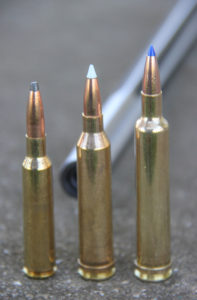
All this has changed in the last decade. The 6.5 Creedmoor and 6.5 Grendel renewed interest in the .264s. Long, heavy bullets with high BCs flew flat, penetrated deep, and recoil was minimal. By this time, powder development permitted more flexibility, and shooters became fascinated by these metrics. The .264 Win. Mag. saw an uptick in sales, and once-obscure rounds like the 6.5-.284 Norma, primarily relegated to long-range shooting applications, began seeing life as a hunting cartridge. Nosler decided to start loading its own headstamped ammo, and its first offering was the successful 26 Nosler, itself a screamer of a cartridge.
When Weatherby decided to enter the 6.5 market, the company immediately went for the top spot. The 6.5-300 Weatherby Magnum bested even the Nosler, with the initial load firing a 127-grain Barnes LRX bullet at 3,531 feet per second (fps) from the muzzle. That equates to better than 3,500 foot-pounds of energy at the muzzle. By comparison, the .260 Remington firing a 120-grain bullet at 2,890 fps produces around 2,225 foot-pounds of energy. The .270 Winchester with a 130-grain bullet at 3,060 fps generates just over 2,700 foot-pounds of punch. In terms of energy alone, the 6.5-300 Weatherby Magnum sits squarely between the .30-06 and .300 Winchester Magnums. At 400 yards, the Weatherby is still generating almost as much energy as the .260 Remington produces at the muzzle.
High velocity and long, heavy-for-caliber bullets equate to excellent downrange trajectory, too. The maximum point blank range of the 127-grain LRX is an astounding 345 yards for a 6-inch kill zone. On most game, with your rifle properly zeroed, you can hold in the center of the vitals and won’t need to adjust for holdover to almost 350 paces. For hunters who don’t want to dial their scope for range — and there are many in this category — flat-shooting cartridges like the 6.5-300 Weatherby Magnum are the answer. The maximum range for most hunters is about 350 yards, and a cartridge like the 6.5-300 takes the guesswork out of shooting.
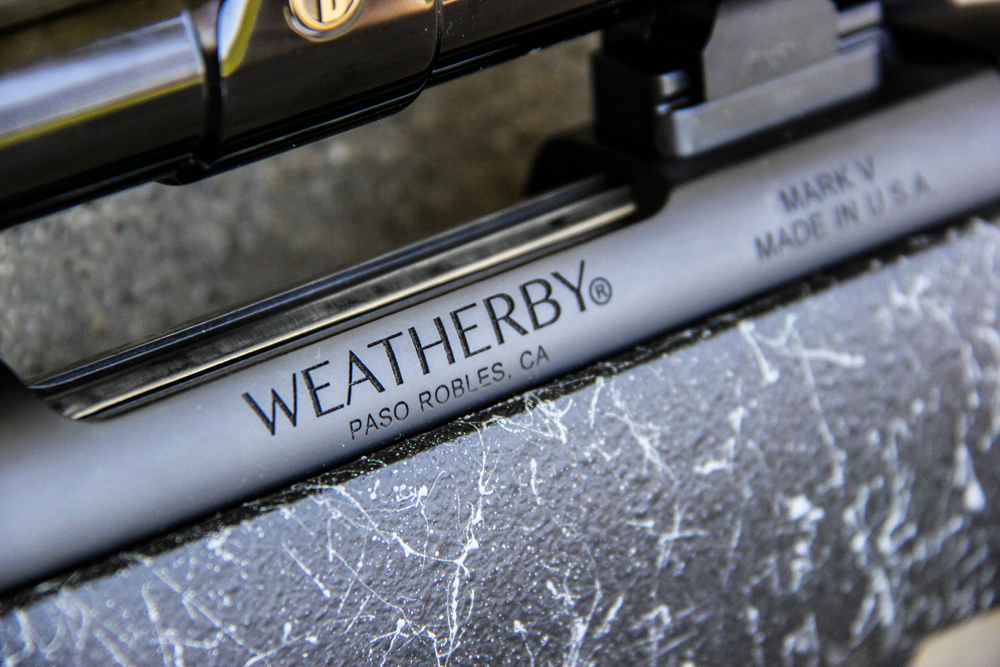
“Since the early days at Weatherby, our family name has been synonymous with ballistic superiority,” said Adam Weatherby, executive vice president and COO of the brand. “The 6.5-300 Weatherby Magnum is proof that Weatherby continues to be the leader in high-velocity cartridges and reinforces our claim that nothing shoots flatter, hits harder or is more accurate. I was able to use the round on several big-game hunts last year and was more than pleased with its performance on shots ranging between 100-400 yards, where the drop was, practically speaking, non-existent. We know that our customers expect high velocity from us and so for Weatherby to introduce the fastest 6.5mm on the planet seemed only fitting.”
Adam Weatherby has probably taken more animals than anyone with the new 6.5-300, so he’s had plenty of chances to see how it performs afield. Last year Adam harvested a Dall sheep, mountain caribou and a bull elk with the rifle — all one shot kills — and Brenda Weatherby, Adam’s wife, dropped a six-point bull elk in Idaho on public land with — you guessed it — one round. The 6.5-300 is well equipped for almost any big game hunt. It would be ideal for long-range shooting on deer (think whitetails in the senderos, cross-canyon shots on muleys or Coues deer in the desert) and mountain sheep. Laser-beam accuracy makes it perfect for antelope, and even though a few critics might dismiss the cartridge as too small for elk, in the right hands and with the right bullet, it has proven effective.
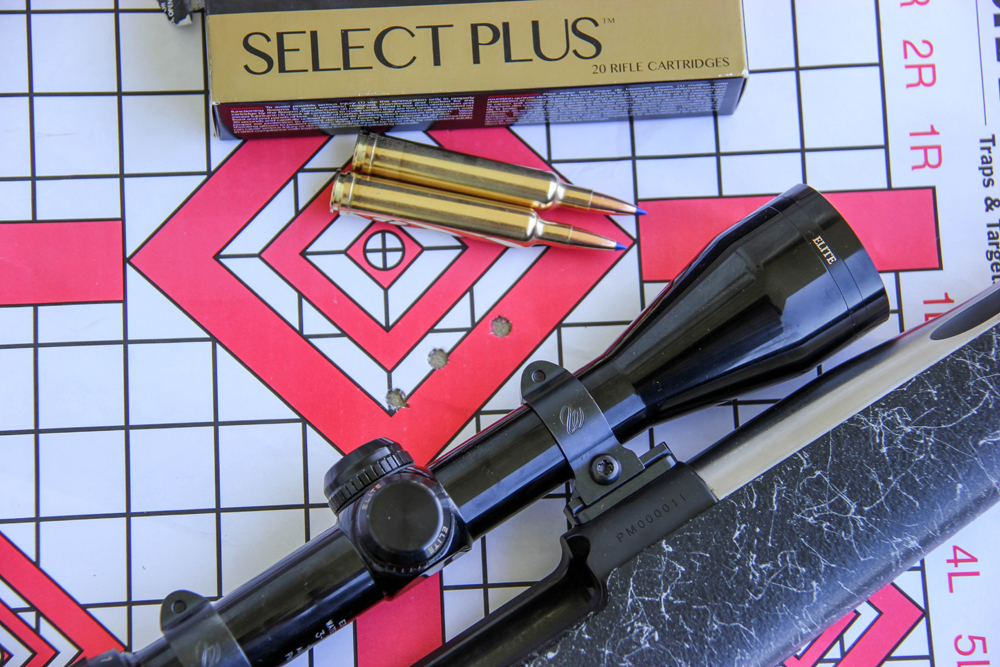
I had a chance to test Weatherby’s new Select Plus 6.5-300 ammo firing the 127-grain Barnes LRX bullets, the only load available at test time (a 130-grain Scirocco and 140-grain A-Frame are coming, too). I was promised 3,531 fps, and the average velocity over my chronograph was 3,520 — less than margin of error — so I’d say Weatherby lived up to its published figures. The rifle I tested was a Mark V Accumark, which comes with a hand-laid composite stock, No. 3 contour stainless fluted barrel and the famed Weatherby nine-lug push-feed action. It’s a sleek, solid rifle that is now backed by a sub-MOA accuracy guarantee.
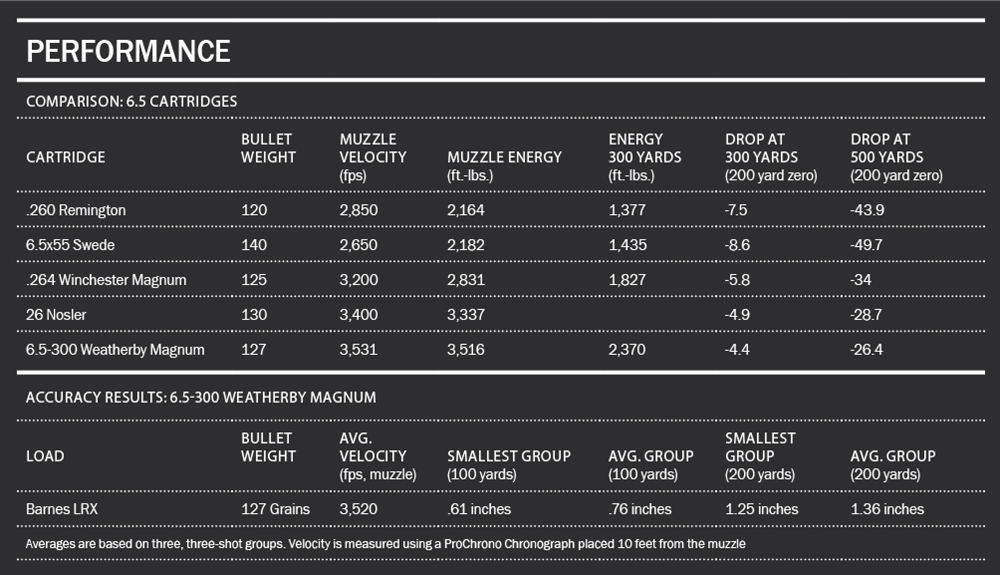

The test rifle managed to best that margin considerably; at 100 yards the smallest three-shot group was .61 inch wide, and the average was just .76 inch for three groups. Thoroughly satisfied with the 6.5-300 Accumark’s performance at 100 yards, I moved to the 200-yard bench. The three test groups at that range measured 1.25 inches, 1.34 inches and 1.49 inches for an average of 1.36 inches, between .6 and .7 MOA. That’s pretty outstanding for an off-the-shelf rifle with factory ammo. Recoil wasn’t punishing; the Mark V has an excellent stock and recoil pad, and with a weight of 8¾ pounds, the Accumark does an admirable job bridling the hyper-velocity 6.5-300. By my estimation, you can expect 7mm Rem. Mag. recoil, certainly less than the .300 magnums generate, but muzzle blast is heavy.
Currently, the 6.5-300 is available in the Mark V line of rifles, which aren’t inexpensive (the Accumark’s MSRP is $2,300). But the Mark V is an extensive line, and there are many options. The Mark V offers a level of build quality and pride of ownership that have been hallmarks of the rifle for over five decades. It’s one of the safest rifles you can buy, and Roy Weatherby painstakingly developed it to handle very hot, high-powered magnums. The new 6.5-300 is certainly powerful, and that cavernous case — with a capacity of roughly 100 grains of water — provides storage for a whole bunch of gunpowder. Like true thoroughbreds, the Weatherby Magnum cartridges thrive when pushed hard. If you think you can handload this cartridge down to modest velocities, you likely won’t be impressed with the results.
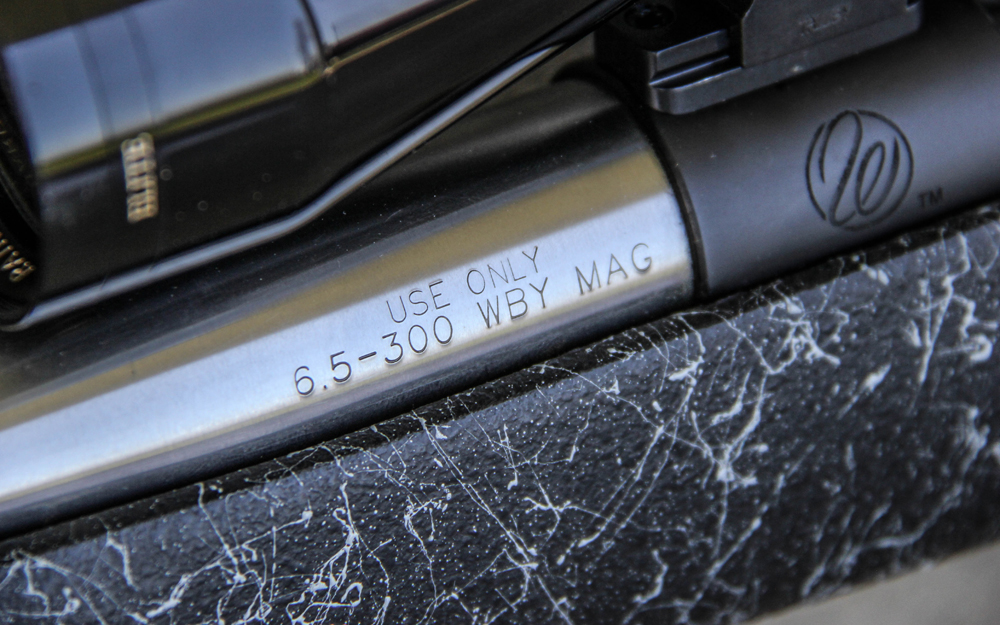 The 6.5-300 Weatherby needs to burn a lot of powder in that quest for 3,531 fps, and loaded ammo is listed at $95 a box. So you can make a reasonable argument against the cartridge in terms of sheer cost of ownership. But Aston Martin wouldn’t sell many cars if they had to justify them as the most frugal option, and James Bond could certainly have driven something more affordable if he simply wanted to get from point A to point B. Speed comes at a price, but the 6.5-300 offers a very flat-shooting, accurate, deadly option, and when coupled with a Mark V rifle and topped with a good scope, there are few animals short of the largest and most dangerous beasts for which this cartridge is not well-equipped, and long-range shooting is made simpler by that pancake-flat trajectory.
The 6.5-300 Weatherby needs to burn a lot of powder in that quest for 3,531 fps, and loaded ammo is listed at $95 a box. So you can make a reasonable argument against the cartridge in terms of sheer cost of ownership. But Aston Martin wouldn’t sell many cars if they had to justify them as the most frugal option, and James Bond could certainly have driven something more affordable if he simply wanted to get from point A to point B. Speed comes at a price, but the 6.5-300 offers a very flat-shooting, accurate, deadly option, and when coupled with a Mark V rifle and topped with a good scope, there are few animals short of the largest and most dangerous beasts for which this cartridge is not well-equipped, and long-range shooting is made simpler by that pancake-flat trajectory.
Roy Weatherby deserves credit for more than launching a string of fast cartridges that bear his name on their headstamps. He ushered in the Magnum Era, and if you thought that era passed into history, think again. Shooters and hunters still love fast loads, and Ed and Adam Weatherby haven’t forgotten that. The 6.5-300 faces stiff competition from other loads, specifically Nosler’s fast 26 that predates it by a couple years, but the Weatherby has muscled its way to the top of the 6.5 hill, and there are precious few things this cartridge won’t do.
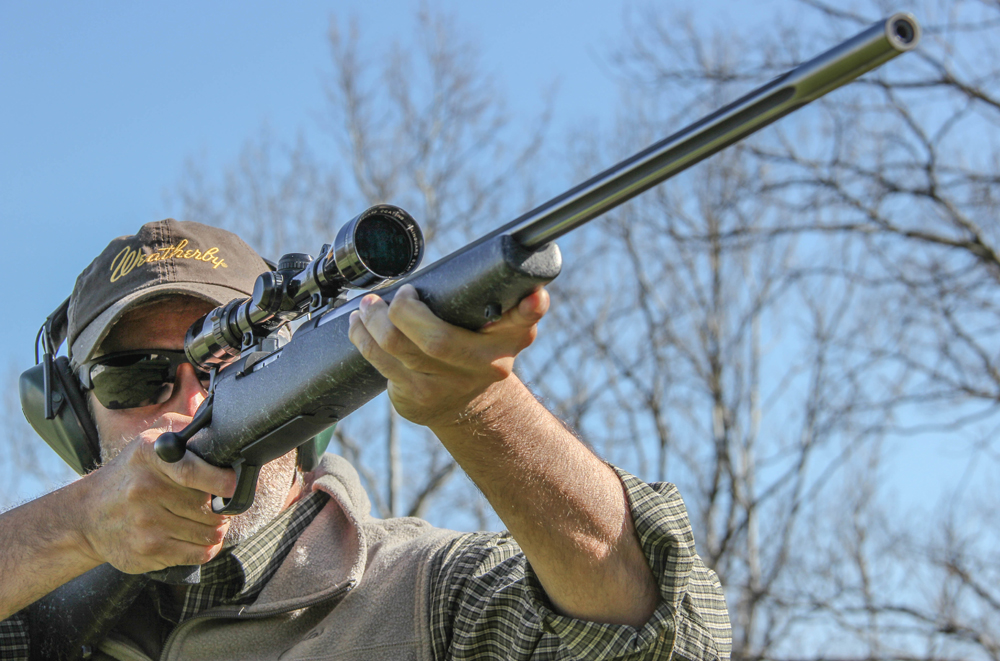 The New Mark V
The New Mark V
The Mark V rifle, introduced in 1958, received a facelift last year. While the heart of the rifle — that nine-lug (six on non-magnums), fluted, vented, push-feed bolt — remains the same, there were some significant changes to the overall design. For starters, the wrist of the stock is slimmer and has a slight palm swell. This ensures a comfortable and secure grip on the rifle and is better for managing recoil. The forearm diameter has been trimmed down as well, and the overall feel of the rifle has been improved.
 The most significant improvements are the addition of a hand-lapped barrel — which allows the brand to offer a sub-MOA accuracy guarantee across the line — and the addition of the new LXX trigger. The LXX has a wider face (wide enough, indeed, for the addition of a Flying W) and engagement surfaces that are precision ground and polished. The result is a crisp, clean, break. The trigger is adjustable down to 2.5 pounds, and that’s where the trigger on the rifle I tested was set. For more information visit Weatherby.com.
The most significant improvements are the addition of a hand-lapped barrel — which allows the brand to offer a sub-MOA accuracy guarantee across the line — and the addition of the new LXX trigger. The LXX has a wider face (wide enough, indeed, for the addition of a Flying W) and engagement surfaces that are precision ground and polished. The result is a crisp, clean, break. The trigger is adjustable down to 2.5 pounds, and that’s where the trigger on the rifle I tested was set. For more information visit Weatherby.com.
Editor's Note: This article is an excerpt from the Summer 2016 issue of Gun Digest the Magazine.

Next Step: Get your FREE Printable Target Pack
Enhance your shooting precision with our 62 MOA Targets, perfect for rifles and handguns. Crafted in collaboration with Storm Tactical for accuracy and versatility.
Subscribe to the Gun Digest email newsletter and get your downloadable target pack sent straight to your inbox. Stay updated with the latest firearms info in the industry.

![Best Concealed Carry Guns In 2025 [Field Tested] Wilson Combat EDC X9S 1](https://gundigest.com/wp-content/uploads/Wilson-Combat-EDC-X9S-1-324x160.jpg)


![Best 9mm Carbine: Affordable PCCs [Tested] Ruger Carbine Shooting](https://gundigest.com/wp-content/uploads/Ruger-Carbine-Shooting-100x70.jpg)
![Best AR-15: Top Options Available Today [Field Tested] Harrington and Richardson PSA XM177E2 feature](https://gundigest.com/wp-content/uploads/Harrington-and-Richardson-PSA-XM177E2-feature-100x70.jpg)
